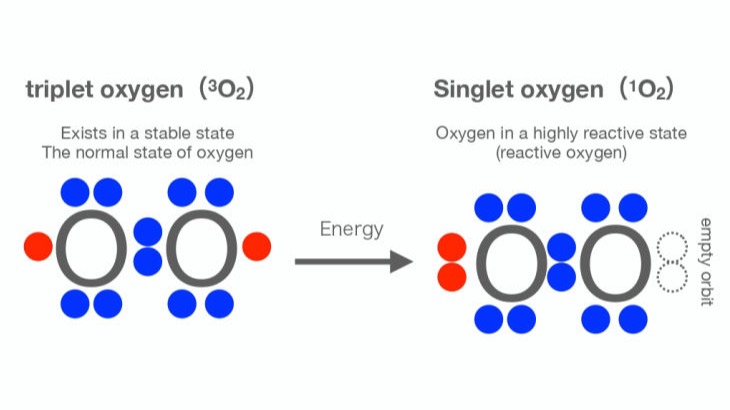Photo-tumor immunity
Advanced cancer treatment using antibody mimetics
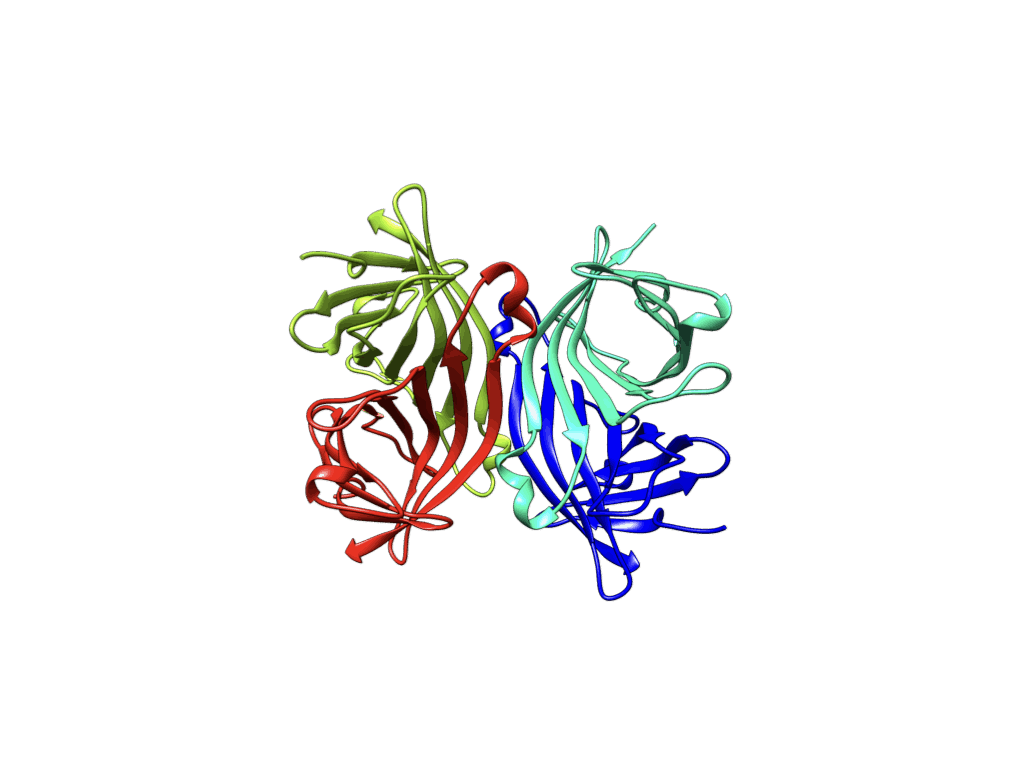
Advanced cancer treatment using antibody mimetics

AT RCAST in the University of Tokyo, we are developing drugs for complete cure of advanced cancer. Antibody-mimetic drug conjugates (AMDC) with low burden and high efficacy rate have been the core of our technologies under Dr. Tatsuhiko Kodama as project leader.
A series of collaborative technology development is a core of our effort.
(1) Identification of druggable protein target using genome science and proteomics (Prof. Shumpei Ishikawa of Medical School of UT, Assoc. Prof Takeshi Kawamura of Isotope Science Center of UT)
(2) Designeand Manufacturing of Antibody-Mimetic (Assis. Prof. Akira Sugiyama of Isotope Science Center of UT, Lecturer Eiichi Mizohata of Osaka University)
(3) New near infrared photoabsorber Ax-SiPC and AMDC system (Prof. Motomu Kanai of Pharmaceutical Sciences of UT)
(4) Duocarmycin and Yatakemycin AMDC (Prof. Hidetoshi Tokuyama of Tohoku University)
(5) Analysis of singlet oxygen generation (Prof. Kei Okubo of Osaka University)
(6) Computational design of antibody mimetics (Assoc Prof Takefumi Yamashita of RCAST, UT)
(7) Intrabody delivered as mRNA drug (Prof. Keiji Itaka of Tokyo Medical and Dental University)
Nov 09, 2022
Sept 20, 2022
Antibody mimetics are proteins with molecular weights of approximately 3-20 kDa that can specifically bind to antigens, similar to antibodies. However, they are structurally unrelated to antibodies. Nucleic acids and small molecule compounds may also be considered antibody mimetics. Advantages compared to antibodies include solubility, tissue penetration, thermal and enzymatic stability, and relatively low production costs. In recent years, the development of therapeutic agents and diagnostic agents using antibody mimetic is progressing. Currently, approximately 18 types of antibody mimetics have been reported, and typical examples of antibody mimetics include Affibodies, Affilins, Affirmers, and Anticlins.
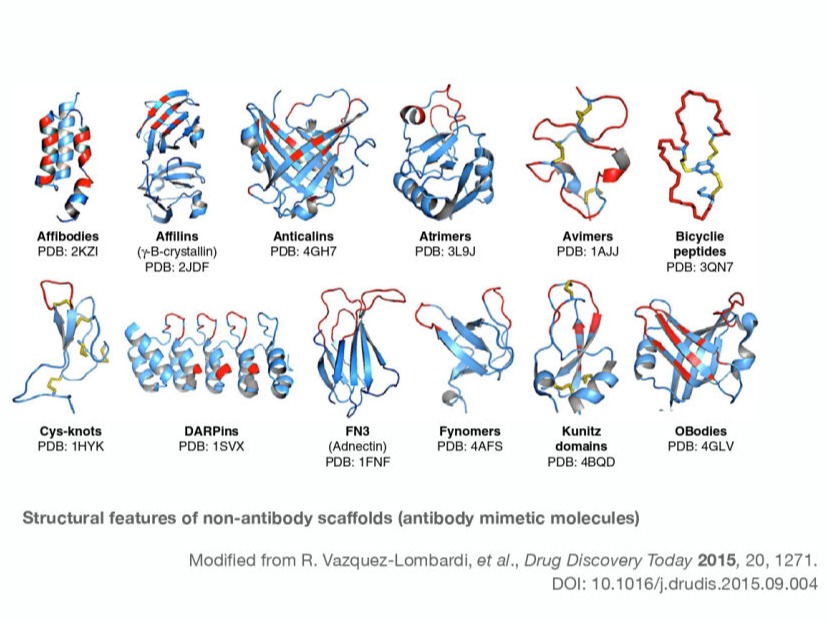
Affibody molecules are a class of antibody mimetic engineered to mimic monoclonal antibodies and bind with high affinity to numerous target proteins or peptides. Affibodies are as small as 58 amino acids (6 kDa) and have high stability against temperature (90˚C) and pH (2.5-11). Affibody molecules consist of a three-helical bundle domain and can be soluble and stably expressed as fusion proteins. Affibodies themselves do not contain cysteine or disulfide bonds, which facilitates microbial production. Target-specific affibodies are screened by display methods such as phage display. Furthermore, binders with picomolar affinities can be produced by affinity maturation. We have successfully developed a new drug AMDC (antibody mimetic drug conjugate) using affibody.
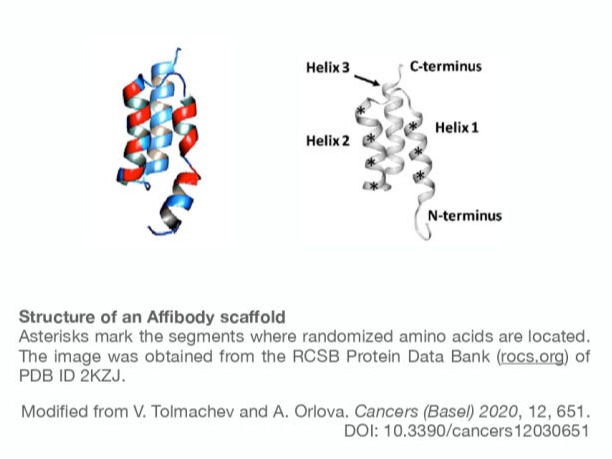
Antibodies of camelids such as llamas and alpacas are composed only of heavy chains, and their variable regions are called VHH (variable domain of heavy chain of heavy chain antibody) antibodies, single domain antibodies (sdAb) or nanobodies. VHH antibodies are highly stable against temperature and pH change. A single chain variable fragment (scFv), which is a common IgG that connects the light chain and heavy chain variable regions with a linker, has a molecular weight of 25 kDa and a complex structure. VHH has a molecular weight of 15 kDa. and has a simple structure. Therefore, low-cost production in microorganisms is possible, and protein engineering modifications such as production of fusion proteins are easy.
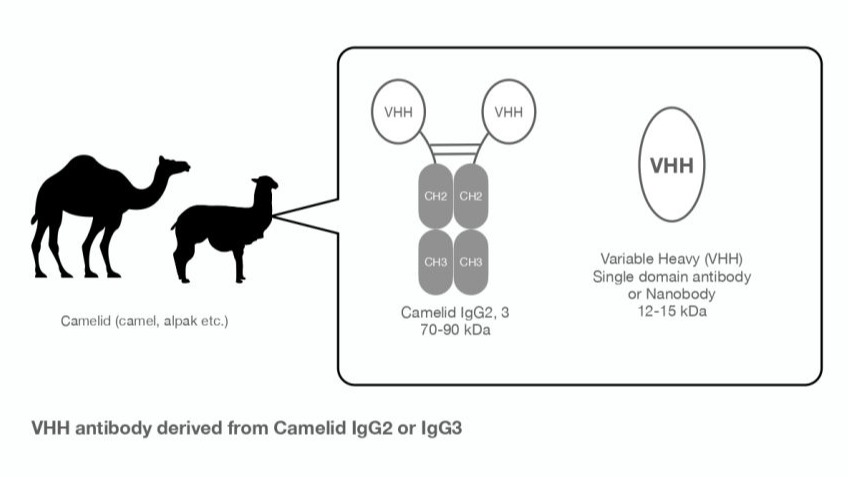
AMDC stands for antibody mimetic drug conjugate and refers to antibody mimetic-based drug delivery systems. We created a fusion of an affibody, one of the antibody mimetic, and a streptavidin variant (Cupid) protein that we developed. The fusion can be non-covalently attached to the Cupid molecule by simply mixing the biotin variant (Psyche) in solution. As a payload, Psyche can be conjugated with a drug for treatment or diagnosis via a linker. Antibody mimetics that target and recognize cell surface proteins, such as cancer cells, enable the delivery of Psyche-linked drugs to target cells. So far, we have succeeded in PET imaging using radionuclides and tumor disappearance using photosensitizers.
Yamatsugu et al. Protein Expr. Purif. 2022, 192, 106043. DOI: 10.1016/j.pep.2021.106043
Sugiyama et al. Proc Jpn Acad Ser B Phys Biol Sci. 2019, 95, 602. DOI: 10.2183/pjab.95.041
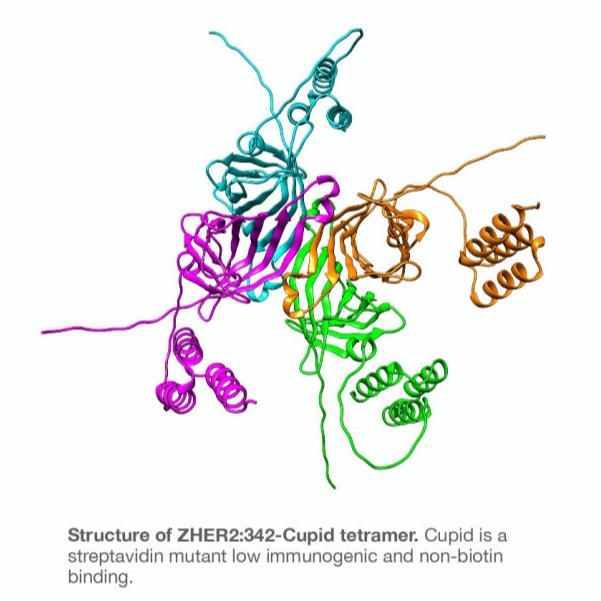
Cupid is a modified streptavidin, which has low immunogenicity in human body. Cupid is also modified to unable to bind to biotin, which exists as a vitamin in the human body. Based on the human proteome sequence, we succeeded in reducing the immunogenicity of streptavidine so that it can be used in the human body. In addition, by modifying the biotin-binding pocket, it does not bind to biotin in the human body and achieves binding with a high affinity to the biotin-modified Psyche molecule.
Yumura et al. Protein Sci. 2013, 22, 213. DOI: 10.1002/pro.2203
Kawato et al. J Biochem. 2015, 157, 467. DOI: 10.1093/jb/mvv004
Kawato et al. J Biosci Bioeng 2015, 119 , 642. DOI: 10.1016/j.jbiosc.2014.10.025
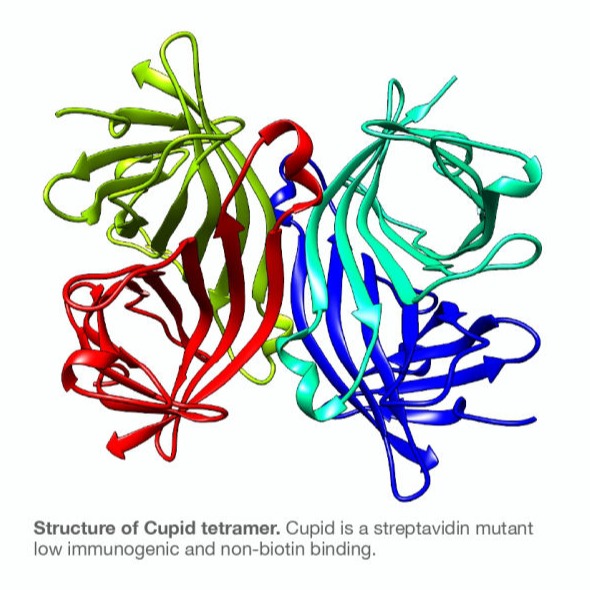
Streptavidin and biotin bind with highest affinity level in natural.compounds. Streptavidine is modified into Cupid in order to reduce anitigeneity and biotin is modified into Psyche in order to avoid competition from existing biotin existing in human body. By replacing one of the oxygen atoms contained in biotin with a nitrogen atom and also by dimerization, Psyche can bind to Cupid with high affinity. Psyche can be conjugated with various payloads, ranging from anticancer drugs, photosensitizers, and radionuclides. and drugs can be selectively delivered. Psyche is a small molecule that can be chemically modified at the atomic level, enabling various tunings according to the purpose.
Kawato et al. Biosci Biotechnol Biochem. 2015, 79, 640. DOI: 10.1080/09168451.2014.991692
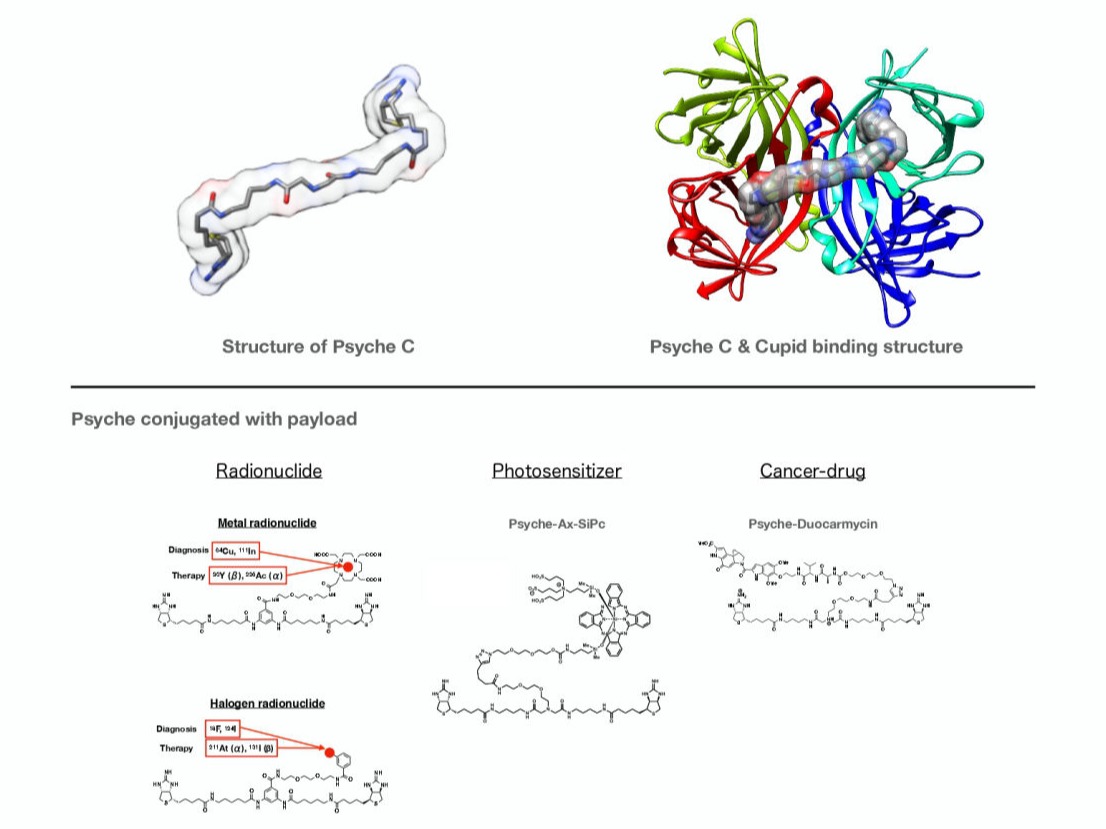
Axially substituted silicon phthalocyanine (Ax-SiPc) is an photoabsorber of near infra red light, Upon absorbing photon at the cell surface, it efficiently generates siglet oxygen and kills attached cells. Near infra red can penetrate into human body, and Ax-SiPc can be activated by extra corporeal irradiation. Based on IR 700 structure, Ax-SiPc can be synthesized more efficiently and more simply than asymmetrical IR-700.
Takahashi K, Sugiyama A, Ohkubo K, et al. Axially substituted silicon phthalocyanine payloads for antibody-drug conjugates. Synlett. 2021;32(11):1098-1103.
Yamatsugu et al. Protein Expr. Purif. 2022, 192, 106043.
Kaneko et al. Cancer Sci. 2022, 113, 4350. DOI: 10.1111/cas.15565
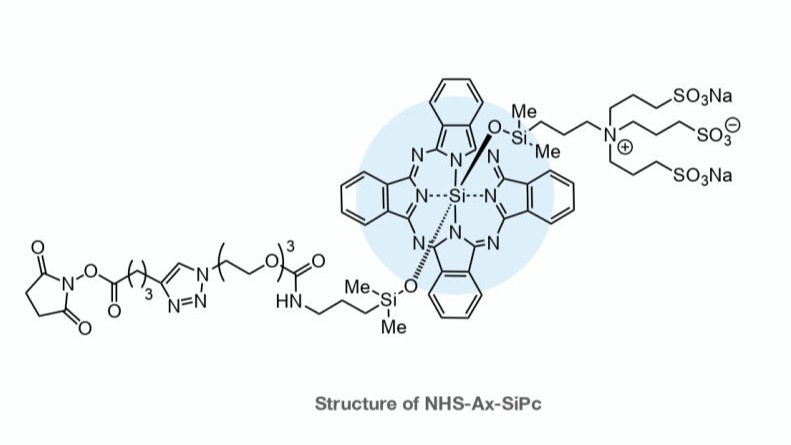
An antibody-drug conjugate currently marketed under the name Acallux uses a photosensitizer called IR700. Although IR700 is a highly effective photosensitizer, its structural complexity makes it inefficient to manufacture and difficult to modify to further improve its pharmaceutical efficacy. By greatly simplifying the structure of IR700, we have developed a photosensitizer that can be produced with less than half the number of synthetic steps and more than ten times the yield while maintaining most of its functions. That is Ax-SiPc. Furthermore, there is data showing that Ax-SiPc is more efficient in generating singlet oxygen than IR700, and it is expected to be used as a more effective photosensitizer.
Takahashi et al. Synlett 2021, 32, 1098.
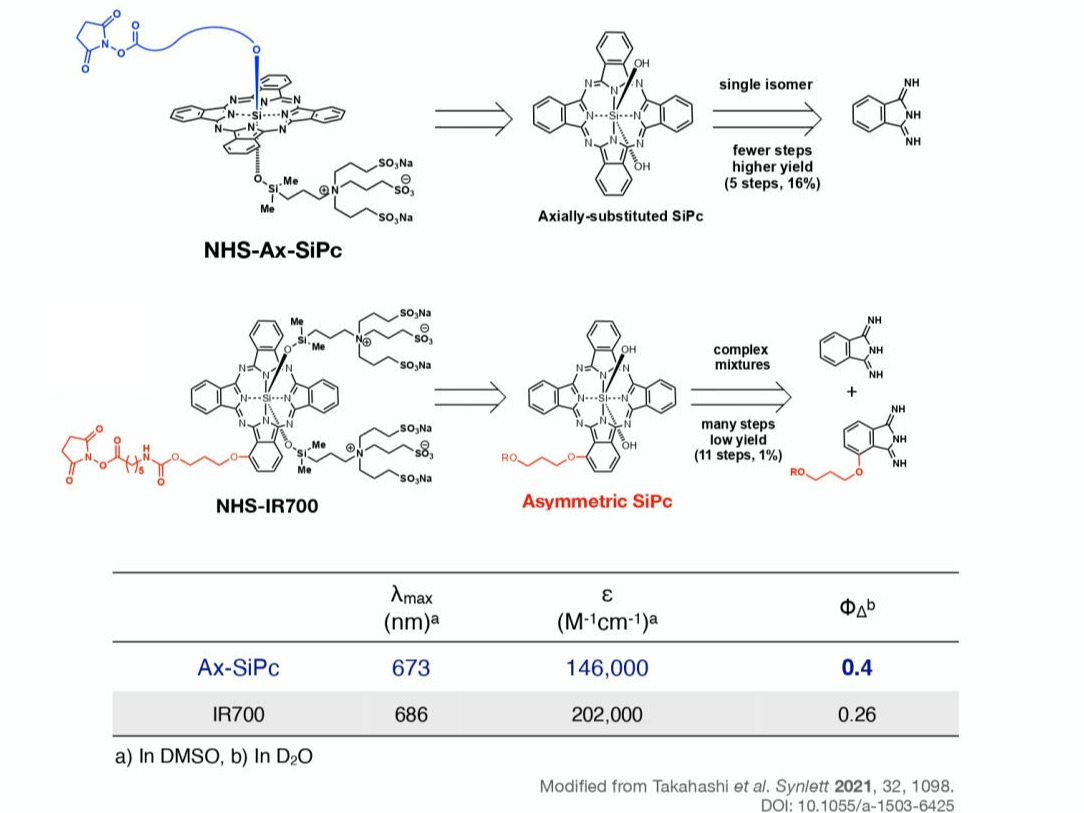
Progress in performance of computers and advances in molecular theory understanding of protein-protein interactions makes it possible computationally designing of small proteins (up to 100 amino acids). These proteins can strongly bind to target proteins. Engineered proteins with this binding ability can be easily fused to Cupid and used as modules for antibody mimetic-drug conjugation (AMDC). Once the target protein is identified, AMDCs can be rapidly developed through computational rational design.
Yamatsugu et al. Protein Expr. Purif. 2022, 192, 106043.
Kaneko et al. Cancer Sci. 2022, DOI: 10.1111/cas.15565
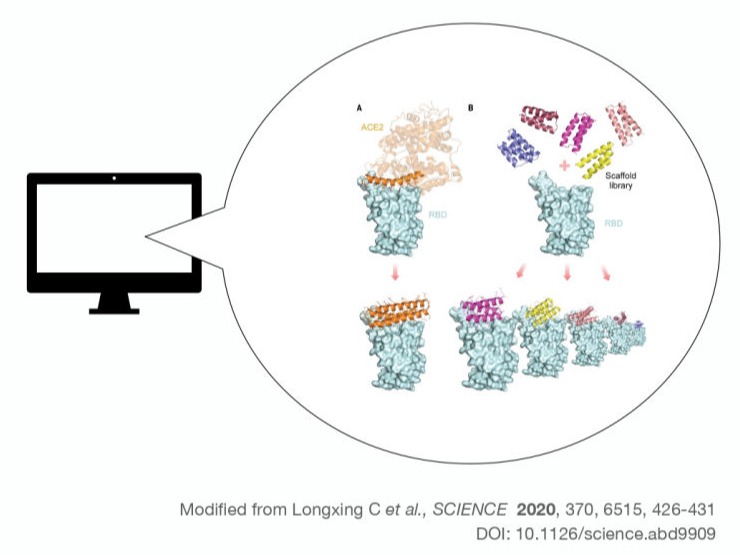
Singlet oxygen is an excited state of oxygen molecules contained in the air. It has extremely high reactivity and can oxidize various biological substances such as proteins and genes. Photosensitization is commonly used to generate such dye molecules, which absorbs ultraviolet light and visible light. In particular, π-type dye molecules such as Ax-SiPc and IR700 have a long lifetime of the triplet excited state generated by absorbing light energy, and can efficiently transfer energy to oxygen, resulting in the generation of singlet oxygen. It is known that the efficiency (quantum yield) is very high. Singlet oxygen can be selectively generated in areas where pigment molecules are accumulated or in areas exposed to light, so it is used in cancer treatment.
